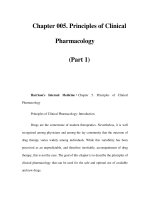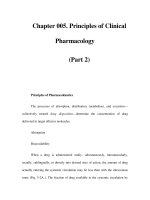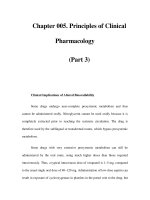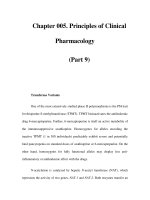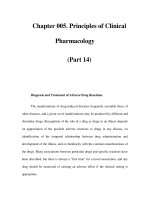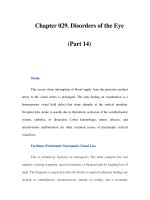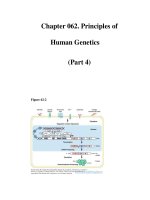Chapter 081. Principles of Cancer Treatment (Part 14) pps
Bạn đang xem bản rút gọn của tài liệu. Xem và tải ngay bản đầy đủ của tài liệu tại đây (15.49 KB, 5 trang )
Chapter 081. Principles of
Cancer Treatment
(Part 14)
Mitomycin C undergoes reduction of its quinone function to generate a
bifunctional DNA alkylating agent. It is a broadly active antineoplastic agent with
a number of unpredictable toxicities, including delayed bronchospasm 12–14 h
after dosing and a chronic pulmonary fibrosis syndrome more frequent at doses of
50–60 mg/m
2
. Cardiomyopathy has been described, particularly in a setting of
prior radiation therapy. A hemolytic/uremic syndrome carries an ultimate
mortality rate of 25–50% and is poorly treated by conventional component support
and exchange transfusion. Mitomycin is a notable vesicant and causes substantial
nausea and vomiting. It can be used for intravesical instillation for curative
treatment of superficial transitional bladder carcinomas and, with radiation
therapy, for curative treatment of anal carcinoma.
Mitoxantrone is a synthetic compound that was designed to recapitulate
features of doxorubicin but with less cardiotoxicity. It is quantitatively less
cardiotoxic (comparing the ratio of cardiotoxic to therapeutically effective doses)
but is still associated with a 10% incidence of cardiotoxicity at cumulative doses
of >150 mg/m
2
. It also causes alopecia. Cases of acute promyelocytic leukemia
(APL) have arisen shortly after exposure of patients to mitoxantrone, particularly
in the adjuvant treatment of breast cancer. While chemotherapy-associated
leukemia is generally of the acute myeloid type, APL arising in the setting of prior
mitoxantrone treatment had the typical t(15;17) chromosome translocation
associated with APL, but the breakpoints of the translocation appeared to be at
topoisomerase II sites that would be preferred sites of mitoxantrone action, clearly
linking the action of the drug to the generation of the leukemia.
Etoposide was synthetically derived from the plant product
podophyllotoxin; it binds directly to topoisomerase II and DNA in a reversible
ternary complex. It stabilizes the covalent intermediate in the enzyme's action
where the enzyme is covalently linked to DNA. This "alkali-labile" DNA bond
was historically a first hint that an enzyme such as a topoisomerase might exist.
The drug therefore causes a prominent G
2
arrest, reflecting the action of a DNA
damage checkpoint. Prominent clinical effects include myelosuppression, nausea,
and transient hypotension related to the speed of administration of the agent.
Etoposide is a mild vesicant but is relatively free from other large-organ toxicities.
When given at high doses or very frequently, topoisomerase II inhibitors may
cause acute leukemia associated with chromosome 11q23 abnormalities in up to
1% of exposed patients.
Camptothecin was isolated from extracts of a Chinese tree and had notable
antileukemia activity. Early clinical studies with the sodium salt of the hydrolyzed
camptothecin lactone showed evidence of toxicity with little antitumor activity.
Identification of topoisomerase I as the target of camptothecins and the need to
preserve lactone structure allowed additional efforts to identify active members of
this series. Topoisomerase I is responsible for unwinding the DNA strand by
introducing single-strand breaks and allowing rotation of one strand about the
other. In S-phase, topoisomerase I–induced breaks that are not promptly resealed
lead to progress of the replication fork off the end of a DNA strand. The DNA
damage is a potent signal for induction of apoptosis. Camptothecins promote the
stabilization of the DNA linked to the enzyme in a so-called cleavable complex,
analogous to the action of etoposide with topoisomerase II. Topotecan is a
camptothecin derivative approved for use in gynecologic tumors and small cell
lung cancer. Toxicity is limited to myelosuppression and mucositis. CPT-11, or
irinotecan, is a camptothecin with evidence of activity in colon carcinoma. In
addition to myelosuppression, it causes a secretory diarrhea related to the toxicity
of a metabolite called SN-38. The diarrhea can be treated effectively with
loperamide or octreotide.
Indirect Effectors of DNA Function: Antimetabolites
A broad definition of antimetabolites would include compounds with
structural similarity to precursors of purines or pyrimidines, or compounds that
interfere with purine or pyrimidine synthesis. Antimetabolites can cause DNA
damage indirectly, through misincorporation into DNA, abnormal timing or
progression through DNA synthesis, or altered function of pyrimidine and purine
biosynthetic enzymes. They tend to convey greatest toxicity to cells in S-phase,
and the degree of toxicity increases with duration of exposure. Common toxic
manifestations include stomatitis, diarrhea, and myelosuppression. Second
malignancies are not associated with their use.
Methotrexate inhibits dihydrofolate reductase, which regenerates reduced
folates from the oxidized folates produced when thymidine monophosphate is
formed from deoxyuridine monophosphate. Without reduced folates, cells die a
"thymine-less" death. N5-tetrahydrofolate or N5-formyltetrahydrofolate
(leucovorin) can bypass this block and rescue cells from methotrexate, which is
maintained in cells by polyglutamylation. The drug and other reduced folates are
transported into cells by the folate carrier, and high concentrations of drug can
bypass this carrier and allow diffusion of drug directly into cells. These properties
have suggested the design of "high-dose" methotrexate regimens with leucovorin
rescue of normal marrow and mucosa as part of curative approaches to
osteosarcoma in the adjuvant setting and hematopoietic neoplasms of children and
adults. Methotrexate is cleared by the kidney via both glomerular filtration and
tubular secretion, and toxicity is augmented by renal dysfunction and drugs such
as salicylates, probenecid, and nonsteroidal anti-inflammatory agents that undergo
tubular secretion. With normal renal function, 15 mg/m
2
leucovorin will rescue 10
–
8
to 10
–6
M methotrexate in three to four doses. However, with decreased
creatinine clearance, doses of 50–100 mg/m
2
are continued until methotrexate
levels are <5 x10
–8
M. In addition to bone marrow suppression and mucosal
irritation, methotrexate can cause renal failure itself at high doses owing to
crystallization in renal tubules; therefore, high-dose regimens require
alkalinization of urine with increased flow by hydration. Methotrexate can be
sequestered in third-space collections and leech back into the general circulation,
causing prolonged myelosuppression. Less frequent adverse effects include
reversible increases in transaminases and hypersensitivity-like pulmonary
syndrome. Chronic low-dose methotrexate can cause hepatic fibrosis. When
administered to the intrathecal space, methotrexate can cause chemical
arachnoiditis and CNS dysfunction.
